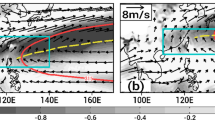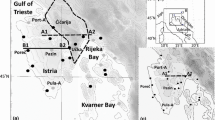Summary
An inviscid form of the hydrodynamical equations is solved with enhanced horizontal shear, which is a synoptic feature consistent with stronger African Easterly Jet (AEJ) in Sahelian dry years, for unstable waves generated along the boundary between the two tropospheric air masses in tropical north Africa (i.e. the moist south-westerlies and the dry north-easterlies). Using a two-layer model of the atmosphere in order to correctly simulate the tropospheric synoptic situation in the sub-region, results show that the mode of the waves which is known to be fundamental to the development of West African squall lines is more unstable in dry years. This instability is found to be most-pronounced when the surface of discontinuity between the south-westerlies and the north-easterlies is at 700 mb level. Further, it is shown that in Sahelian dry years, the zone of these unstable waves shifts slightly southwards. This shift causes a deficit in rainfall in West African isohyet bands north of latitude 12°. The persistence of this deficit is linked with the continuous warming, in July, August and September of the 18-year period 1969–1986, of the three oceans (Indian, Pacific and South Atlantic) whose sea-surface temperature (SST) anomalies influence rainfall in tropical north Africa. It is shown that anytime these oceans warm up anomalously, the strength of the AEJ is enhanced leading to the climate-change process of: SST anomaly, increased AEJ strength, southward shift of the zone of squall-inducing waves and consequent reduction in total annual rainfall north of latitude 12° in tropical north Africa.
Similar content being viewed by others
References
Adedoyin, J. A., 1989a: Global-scale sea-surface temperature anomalies and rainfall characteristics in Northern Nigeria.J. Climatol.,9, 133–144.
Adedoyin, J. A., 1989b: Initiation of West African squall lines.Meteorol. Atmos. Phys.,41, 99–103.
Adedoyin, J. A., 1989c: Wave propagation and amplification along the surface of discontinuity between air masses of different atmospheric static stabilities: A case study of west African tropospheric air masses.Meteorol. Atmos. Phys.,41, 105–112.
Albignat, J. P., Reed, R.J., 1980: The origin of African wave disturbances during Phase III of GATE.Mon. Wea. Rev.,108, 1827–1839.
Bolton, D., 1984: Generation and propagation of African squall lines.Quart. J. Roy. Meteor. Soc.,110, 695–721.
Druyan, L. M., 1989: Advances in the study of Sub-Saharan drought.J. Climatol.,9, 77–90.
Dudhia, J., Moncrieff, M.W., So, D.W.K., 1987: The two-dimensional dynamics of West African squall lines.Quart. J. Roy. Meteor. Soc.,113, 121–146.
Eldridge, R. H., 1957: A synoptic study of West African disturbance lines.Quart. J. Roy. Meteor. Soc.,83, 303–314.
Hamilton, R. A., Archbold, J. W., 1945: Meteorology of Nigeria and adjacent territory.Quart. J. Roy. Meteor. Soc.,71, 231–265.
Hane, C. E., 1973: The squall line thunderstorm: Numerical experimentation.J. Atmos. Sci.,30, 1672–1690.
Janicot, S., 1992: Spatiotemporal variability of West African rainfall. Part II: Associated surface and airmass characteristics.J. Climate. 5, 499–511.
Landsea, C. W., Gary, W. M., 1992: The strong association between Western Sahelian monsoon rainfall and intense Atlantic hurricanes.J. Climate,5, 435–453.
Landsea, C. W., Gray, W. M., Mielke, P. W. Jr. Berry, K. J., 1992: Long-term variations of Western Sahelian monsoon rainfall and intense U. S. landfalling hurricanes.J. Climate,5, 1528–1534.
Landsea, C. W., 1993: A climatology of intense (or major) Atlantic hurricanes.Mon. Wea. Rev.,121, 1703–1713.
Miller, M. J., 1974: On the use of pressure as vertical coordinate in modelling convection.Quart. J. Roy. Meteor. Soc. 100, 155–162.
Newell, R. E., Kidson, J. W. 1984: African mean wind changes between Sahelian wet and dry periods.J. Climatol.,4, 27–33.
Omotosho, J. 'Bayo 1985: The separate contributions of squall lines, thunderstorms and the monsoon to the total rainfall in Nigeria.J. Climatol.,5, 543–552.
Omotosho, J. 'Bayo., 1990: Onset of thunderstorms and precipitation over Northern Nigeria.Int. J. Climatol.,10, 849–860.
Palmer, T. N., 1986: Influence of the Atlantic, Pacific and Indian Oceans on Sahel rainfall.Nature,322, 251–253.
Pasch, R. J., Avila, L. A., 1994: Atlantic tropical systems of 1992.Mon. Wea. Rev. 122, 539–548.
Reed, R. J., 1988: On understanding the meteorological causes of Sahelian drought.Pontificae Academiae Scientiarvm Scripta Varia,69, 179–213.
World Meteorological Organisation, 1985: The global climate system: Autumn 1982 Spring 1984, World Climate Data Programme Contribution of Global Environmental Monitoring System (GEMS), WMO, Geneva.
Author information
Authors and Affiliations
Additional information
With 5 Figures
Rights and permissions
About this article
Cite this article
Adedoyin, J.A. Instability of squall-inducing waves, global sea-surface temperature anomalies and climate change in tropical north Africa. Meteorl. Atmos. Phys. 62, 79–89 (1997). https://doi.org/10.1007/BF01037481
Received:
Revised:
Issue Date:
DOI: https://doi.org/10.1007/BF01037481




